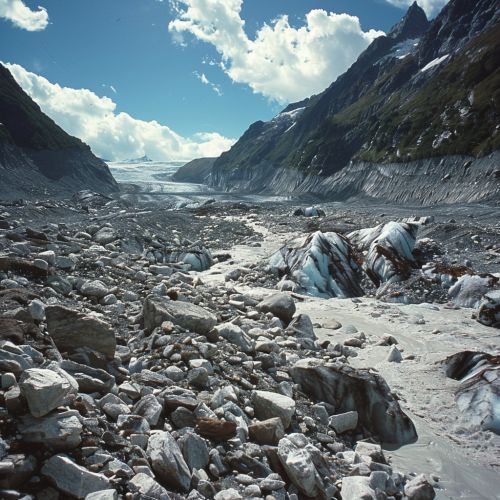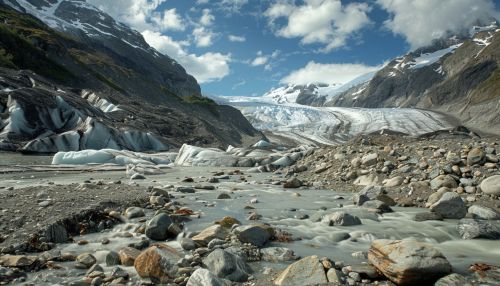Glacial Transport
Introduction
Glacial transport is a geological process involving the movement of material by glaciers. It is a significant component of the broader field of glaciology, which studies the various physical attributes and impacts of glaciers. Glacial transport can occur through two primary mechanisms: glacial erosion and glacial deposition.


Glacial Erosion
Glacial erosion is the process by which glaciers wear away the landscape. This occurs through two main processes: abrasion and plucking.
Abrasion
Abrasion is the process by which the glacier grinds along the bedrock, wearing it away. This is facilitated by the debris embedded in the base and sides of the glacier, which acts like sandpaper against the underlying rock. The result is a smooth, polished surface often striated with long parallel grooves known as glacial striations.
Plucking
Plucking is another form of glacial erosion where the glacier freezes onto the bedrock and, as it moves, it pulls out large chunks of rock. This process is most effective in areas where the bedrock is fractured or weakened.
Glacial Deposition
Glacial deposition is the process by which material transported by a glacier is released or dropped. This occurs when the ice melts or when the glacier's carrying capacity is exceeded. The deposited material is known as glacial till.
Types of Glacial Deposits
There are several types of glacial deposits, including moraines, drumlins, and erratics.
Moraines
Moraines are accumulations of dirt and rocks that have fallen onto the glacier surface or have been pushed along by the glacier as it moves.
Drumlins
Drumlins are elongated, teardrop-shaped hills of till that are streamlined in the direction of ice movement.
Erratics
Erratics are large boulders that have been transported and deposited by a glacier, often over long distances.
Impacts of Glacial Transport
The impacts of glacial transport are wide-ranging and significant. They include the creation of distinctive landforms, changes to ecosystems, and impacts on human activities.
Creation of Distinctive Landforms
Glacial transport is responsible for creating a variety of distinctive landforms. These include U-shaped valleys, hanging valleys, cirques, and fjords, among others.
Changes to Ecosystems
Glacial transport can also have significant impacts on ecosystems. The movement of glaciers can dramatically alter landscapes, creating new habitats and disrupting existing ones.
Impacts on Human Activities
Glacial transport can also impact human activities. For example, glacial deposits often contain valuable resources such as sand, gravel, and clay, which are used in construction and other industries.
